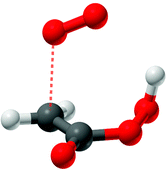Master equation simulations of competing unimolecular and bimolecular reactions: application to OH production in the reaction of acetyl radical with O2†
Abstract
Master equation calculations were carried out to simulate the production of ![[double bond, length as m-dash]](https://www.rsc.org/images/entities/char_e001.gif) O)˙) with molecular oxygen. In particular, the competition between the unimolecular reactions and bimolecular reactions of vibrationally excited intermediates was modeled by using a single master equation. The vibrationally excited intermediates (isomers of acetylperoxyl radicals) result from the initial reaction of
O)˙) with molecular oxygen. In particular, the competition between the unimolecular reactions and bimolecular reactions of vibrationally excited intermediates was modeled by using a single master equation. The vibrationally excited intermediates (isomers of acetylperoxyl radicals) result from the initial reaction of


 Please wait while we load your content...
Please wait while we load your content...